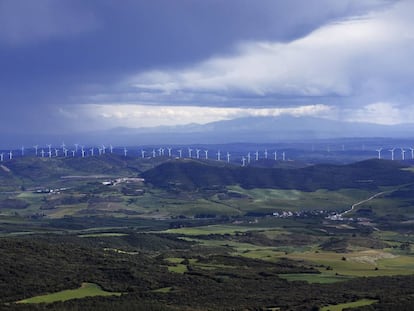Cruise ships: the giants of the sea that leave no one indifferent
The ‘MSC Meraviglia’ is one of the biggest passenger ships in Europe. A floating hotel that can hold up to 5,714 guests. This is the story of the construction in France of the vessel, and its first stop in Barcelona: a portrait of a thriving industry, but one that is facing more and more criticism

It’s the beginning of June, 2017. A group of seniors stands on the Porta d’Europa bridge in the port of Barcelona, taking pictures of the arrival of cruise ships. They’re not bothered by the midday sun beating down on their heads. At 1.30pm one of the big ones arrives. They grab their digital cameras so that they can get a shot of the floating city that is the MSC Meraviglia.
The vessel, which is one of the biggest and most advanced ever constructed by a European shipowner (in this case, MSC Cruises), can hold as many as 5,714 passengers and 1,540 crew members. Once it has moored in Barcelona, the first tourists disembark. Dozens of buses await them in the parking lot, ready to whisk them downtown.
Stella González, 19, is waiting in line to get onto one of the vehicles, accompanied by her mother, her aunt, her grandmother and her partner. They are from Le Havre, the port on the French Atlantic coast from which the Meraviglia – the name means “marvel” – departed, and they are anxious to get to know Barcelona.
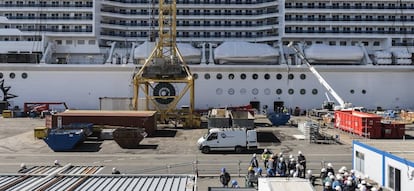
Over the six days they have spent on board the cruise ship, they have been able to enjoy exclusive performances by Cirque du Soleil, Formula 1 simulators, and Broadway-style shows. Because the new jewel in the crown of European ship owner MSC Cruises, is, above all else, a colossal theme park designed so that its passengers will not have to be bored for even a moment.
Waiting in the opposite line to that of Stella are the passengers due to embark in the Catalan capital today. Three women aged around 40 are telling each other about all of the clothes that they have brought with them for the trip. They work at Spain’s Cruceritis travel agency, and they already know what they’ll be doing first once on board: enjoying an Aperol Spritz. “It’s typical of MSC; as they’re Italian, they do it all so well,” explains Inmaculada Pardo, the owner of the agency, with unbridled enthusiasm. “These trips are addictive. Have you ever tried one?”
The new jewel in the crown of European ship owner MSC Cruises, is, above all else, a colossal theme park
It’s the end of March, 2017. The open-air bar on the deck where these women will be enjoying their coveted cocktail is in a state of complete chaos. It’s a jumble of wires, bags of cement, wooden panels and furniture that’s yet to be put in place. Thousands of workers are going flat out to finish off the work and get the Meraviglia ready.
This naval mega-construction – which has a length of 315 meters, a width of 43 meters and a height of 65 meters – was built at the Saint-Nazaire shipyard, located near Brittany. The loudspeakers on the vessel spew out the same phrase every five minutes: “Attention: un, deux, trois, quatre.” The sound checks don’t appear to bother the painters, carpenters, electricians, engineers, crane operators, plumbers and other workers on the job.

In the central mall area, which will house restaurants, luxury stores and bars, a dozen or so drills are all whining at the same time, accompanied by the noise of sanders and the shouts of a man on a scaffold who’s calling for more paint.
The only thing that’s really been finished here already is the ceiling, which is covered by a giant LED screen that will be used to create a digital sky. The music in the background is reggaeton – a solid rhythm to keep the work up in time to meet the delivery deadline: May 31.
Any eccentricity goes in the bid to claim the throne as the king of the seas, and attract the biggest number of passengers
The Swarovski crystal stairway at reception is already in place. Any touch of eccentricity goes in the bid to claim the throne as the king of the seas, and attract the highest number of passengers – the type of passenger who wants a lot of fun on board, who wants to visit different cities without having to drag around suitcases, and prioritizes affordability.
Over the last decade, the demand for cruises has shot up by 62% all over the world. In 2015, around 23 million passengers got on board the nearly 500 ships that sail on seas, oceans and rivers all over the globe. More than half of those people came from North America and Europe. The preferred routes are through the Caribbean and the Mediterranean. That year, the global turnover for the industry was as high as €105 billion, according to the Cruise Lines International Association, which represents the biggest shipping companies in the world. This year, the number of passengers is likely to reach nearly 26 million. The rude health of the industry has prompted companies to increase their fleets and to take on increasingly ambitious projects. There are nearly 100 new ships on order between now and 2026. All of them aim to pollute less, offer the highest level of technology on board and to dazzle their passengers with the most sophisticated designs.
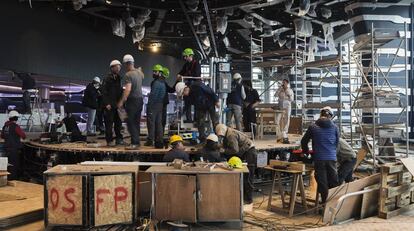
The MSC Meraviglia falls within this category of latest-generation vessels. Back in March, the first shift at the STX France shipyard, in Saint-Nazaire, began work at 5am, before the sun had come up above the Loire and with the damp cold of the Atlantic clawing at overall-clad workers. There is not long to go until the job needs to be finished, but there’s still plenty to do.
“We need to check all of the wiring, finish off the stage in the theater where Cirque du Soleil will perform – you have no idea how hard it’s been to integrate a show with these characteristics in the boat – fit the carpet…,” explains naval architect Guillaume Lagrée, who has been working on the project from its beginning.
The good health of the industry has prompted companies to increase their fleets and to take on ever-more ambitious projects
“The meetings with the Italian-Swiss shipowner MSC Cruises began in 2013. That was when we started to set out what the public spaces and the people flow would be like,” explains Lagrée, who is wearing blue overalls, enormous transparent safety glasses and a white helmet. During that stage, the architects faced the dilemma of whether to use more space for the cabins or to make the lounges and exterior areas bigger.
“The sense of space is vital on a boat, given that you’ve got nowhere to go if you start feeling overwhelmed,” explains Jaime Oliver, the founder of the Basque naval architecture studio Oliver Design. What’s more, the schedule will determine the quality of a cruise. “That’s why it’s so important to come up with multi-use spaces that change during the day,” adds Oliver, who designed a yacht for Donald Trump in the 1990s. In the case of the MSC Meraviglia, the basketball court transforms into a dance floor at night.
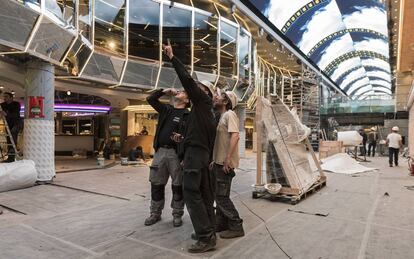
For Lagrée, this process, during which shipowners explain how they envision a boat in their minds, and shipbuilder's architects propose different formulas, is “the most fun part” of the entire project. Everything changes once the contract is signed, however. “From that moment on we’re robots,” he jokes.
The starting gun for the beginning of construction was fired in April 2015, when the first piece of steel was prepared. A total of 35,000 tons of the metal was needed to construct the MSC Meraviglia. The hull alone has more than 300,000 different components. On board, meanwhile, first to be installed were the 2,244 prefabricated cabins, which are put in place by a number of cranes. “It’s like a game of Tetris,” explains Lagrée.
On board, first to be installed were the 2,244 prefabricated cabins, which are put in place by a number of cranes. “It’s like a game of Tetris”
The boat floated for the first time in September 2016. “That’s one of the most exciting days,” explains Lagrée, who is from Saint-Nazaire, about an hour’s drive from Nantes. The city, which was once a base for Nazi submarines, was bombed by the Allies in 1943 and had to be completely rebuilt after the Second World War. Here, naval activity is still one of the symbols of French industrial pride, and provides direct and indirect jobs for nearly 7,000 people.
Since 2008, the shipyard had belonged to the South Korean group STX, which, after declaring bankruptcy and awakening the ghost of economic decline in the area, was forced to sell up. In April, the Italian shipowner Fincantieri, another of the world’s biggest builders of cruise ships, agreed to a deal to buy the shipyard. The French government, which held 33% of the shares in the shipyard, approved that agreement. But French President Emmanuel Macron later called for the deal to be renegotiated. Some said the new French president did not approve of one of the jewels of the Atlantic coast ending up in Italian hands, and feared for the future of the jobs in the sector. The dispute will have to be settled soon, however, given that Saint-Nazaire has to fill all of its orders.
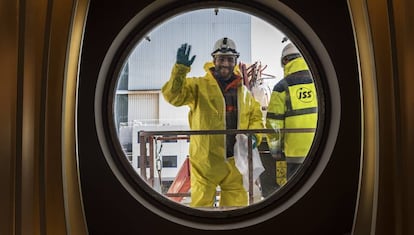
Lagrée is currently working on four projects at the same time. “The priority is the Meraviglia,” he explains from the deck, at the Atmosphere Pool, one of the four swimming pools on the ship, and which is still half finished. “At this point, the most important thing is the work of coordination and checking that everything works,” he adds.
That’s something that technical supervisor Giuseppe Maresca, aged 30, knows only too well. One of his jobs is to check the materials in each area. Today he has gone over the water park, which includes an attraction known as the Himalayan Bridge, a circuit that includes a zip-wire. “I checked that the material wasn’t slippery and that the higher structures are lighter so that they take the weight better,” explains Maresca, who is from Sorrento.
That coastal town in southwestern Italy also happens to be the home of the Aponte family, who own MSC, one of the shipping companies that has grown the most in recent years. Over the next decade, the company – which is based in Geneva – is planning to invest €9 billion on the construction of 11 new vessels. “All of them will count on the latest advances in technology and respect for the environment, explains Emiliano González, the director of MSC Cruises Spain.
Over the next decade, MSC – which is based in Geneva – is planning to invest €9 billion on the construction of 11 new vessels
There is concern in the sector over the bad image these vessels have in terms of their environmental effect. Marta García, a spokesperson for Spanish environmental group Ecologists in Action, explains that these boats are still using fuel oil as their main source of energy. This contaminates 3,500 times more than diesel, but happens to be cheaper. García points to a study published by German environmental organization Nabu, which explains that the bigger cruise ships emit as much CO2 as 83,678 cars, and as much sulfur as 376 million vehicles.
“The new regulations oblige boats to reduce the level of sulfur (from 3.5% to 0.1%) when they approach the coast, but on the high seas the pollution level is the same,” García explains. “And we still don’t know how much toxic air we are breathing in Barcelona due to the huge chimneys that rise up from these monsters.” When moored, the majority of the cruise ships continue to burn fuel, given that they cannot connect to the electricity network.
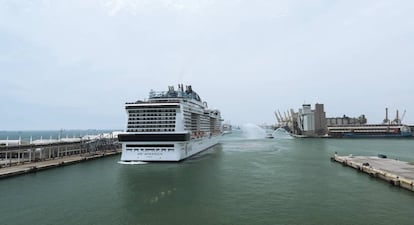
On June 9, the MSC Meraviglia moors in Barcelona. After a six-day journey, it drops anchor at what will be one of its base ports. Sergio Massot, a 47-year-old ventriloquist, awaits his turn to board. “I speak seven languages and I do a number of comedy shows as part of my contract with MSC,” he explains, dressed in a tight black shirt and with slicked-back hair.
The Catalan capital received 2.6 million cruise ship passengers last year, who spent €875 million and provided work for 7,618 people. Barcelona’s port is fourth in the world ranking for cruise ship ports, with Miami in top spot. But there is an increasing number of people who do not see this kind of tourism in a positive light. “You have no idea what it is like to be walking through the city and to suddenly see that massive offloading of people,” says Daniel Pardo, who is from an association that campaigns for sustainable tourism in the city.
“The surveys say that 86% of residents see benefits from tourism, but also that 48% call for it to be limited,” explains Agustí Colom, the councilor for the sector at Barcelona’s City Hall. It’s a difficult equation in terms of keeping residents and businesses happy. Colom admits that the port is an important factor in terms of pollution levels, but argues that the data they have does not distinguish between merchant ships, which are far more polluting, and cruise ships.
You have no idea what it is like to be walking through Barcelona and to suddenly see that massive offloading of people Daniel Pardo, sustainable tourism activist
“Where we have advanced is in terms of the concept of the port as a base, so that the city doesn’t get overloaded in a short space of time,” says Colom. As such, passengers arrive well before they board – thus spending more money in hotels – and also avoiding overcrowding.
Barcelona doesn’t want to end up like Venice, which has been abandoned by its locals after years of mass tourism. The Italian Environmental Fund (FAI), an institution that protects the country’s heritage, has been issuing warnings for years about the negative effect on Venice’s historic canals that cruise ships have. “Venice and its lagoon deserve a strategic plan for the reorganization of its cultural and tourist offerings that is more geared toward sustainability and the protection of its buildings,” explains Andrea Carandini, the fund’s president. Cruise ship companies are very aware of these criticisms. “Local activism has grown with respect to the impact of cruise ships,” admits Kyriakos Anastassiadis, the president of the Cruise Lines International Association in Europe.
An investigative report entitled “Vacations in No Man’s Seas,” produced by Univisión and which won an Ortega y Gasset journalism prize in 2017, also denounces the conditions of workers on the high seas, as well as the fiscal arrangements of the three main companies (Royal Caribbean, Carnival and Norwegian).
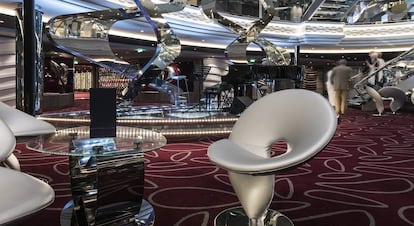
The sector argues that more and more vessels – like the MSC Meraviglia – count on new systems that reduce air pollution, treat waste liquids and reduce the consumption of energy. “The new generation [vessels] will work with natural liquid gas, which is the cleanest fuel in existence,” explains Belén Wangüemert, vice-president of Royal Caribbean International in Europe.
There’s a lot of business at stake, and now is the time to reformulate the industry in order to continue attracting passengers. Carmen Castillo and Javier Jordana have already been won over. This retired couple from Catalonia are MSC gold customers. They will be taking a cruise next week, but as they have VIP access, they have been able to get an early peek at the vessel. “I’m told there’s a special pass for the spa that costs €49.99 that includes a treatment with hyaluronic acid,” says Carmen, while constantly snapping photos that she can post on her Facebook profile, to show off her “super-trip” to her friends.
English version by Simon Hunter.

